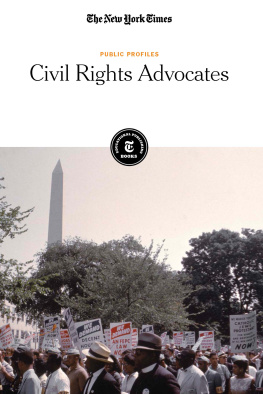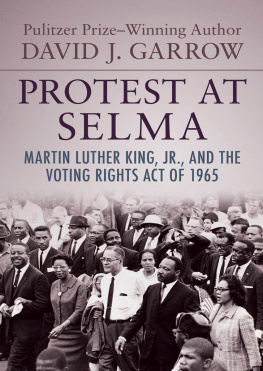The Story of the SELMA VOTING RIGHTS MARCHES in Photographs
The Civil Rights Act of 1964 was a momentous victory for civil rights activists. But one major obstacle remained in the path toward equal rights for African Americans: the right to vote. In the South, segregationists prevented African Americans from voting. Civil rights leaders believed it was time for strong action and chose Selma, Alabama, as the rallying point. There, the marches and protests captured the nation's attention. Through gripping primary source photographs, author David Aretha explores this important time in American history.
About the Author
David Aretha, editor of the acclaimed Civil Rights Chronicle: The African-American Struggle for Freedom, has written numerous books on the subject for young readers.


Image Credit: AP Images / Horace Cort
In Selma, Alabama, whites welcomed black citizens into their stores to spend money. However, whites did everything they could to prevent African Americans from voting.
Can you answer the following question?
The power of granting patents, that is, of securing to inventors the exclusive right to their discoveries, is given to the Congress for the purpose of __________.
The fill-in-the-blank answer is promoting progress. But dont feel bad if you didnt know that. Virtually nobody does. Yet at one time, that was a question African Americans had to answer correctly to be able to vote in the South. White political leaders created these nearly impossible tests so that black citizens would fail them. Usually, they did.
From the 1860s until the 1960s, the American South was a segregated society. A segregated society means that the dominant racial group separates and mistreats a less-powerful group. After enslaving black Americans from the 1600s until slavery was abolished in 1865, southern whites fiercly resisted giving blacks equal rights. Whites had enjoyed the benefits of being the dominant racial group. They didnt want to give that up. For one thing, they still wanted to exploit black workers by paying them low wages.
Also, because most southern whites considered blacks inferior, they did not want to share facilities with them. Black citizens had to attend their own schools and sit in the back of the bus. They had to use the colored drinking fountains and sit in the black sections of the theater. These are just a few examples of life in the Jim Crow (segregated) South. Because of these segregation practices, many African Americans tended to have low self-esteem. And because their wages were low and schools were inferior, most black families remained in poverty.
Southern whites also kept black people down by denying them their voting rights. The 15th Amendment to the U.S. Constitution was passed in 1870. It gave black adult males the right to vote. (Adult women would be granted that right in 1920.) But in 1876, the U.S. Supreme Court ruled that the 15th Amendment didnt guarantee adult male citizens the right to vote. Based on that ruling, southern politicians came up with ways to deny African Americans the vote.
Why did southern whites want to do that? Because a large percentage of the population in the South was African American. Many communities had more black residents than whites. If black people could vote, they might vote many black candidates into office. That would mean that southern whites would lose much of their power. Black leaders would want to get rid of Jim Crow laws. Without unjust laws in place, the Souths segregated society would likely unravel.
Southern whites created several ways to prevent black citizens from voting. In some states, black and white people had to pay a poll tax. This meant that they had to pay a fee to the state in order to vote. Since many black people couldnt afford the tax, they did not vote. Some southern legislatures enacted literacy tests. To pass a literacy test, citizens had to prove that they could read and write. Because black schooling was so bad, many African Americans had poor reading skills. They couldnt pass the literacy test. Many low-income whites had poor literacy skills, too, but election officials passed them anyway.
Then there were the interpretation tests, which had questions like the one that began the introduction. Interpretation tests required would-be voters to interpret U.S. or state constitutions or local ordinances. These tests, which often were required as part of the voting registration process, were difficult. Few blacks, or whites, could pass these tests. But southern officials didnt give the test to many whites. In other cases, they helped the whites answer the questions. Or they passed a white applicant and failed a black applicant even if they had the same score. The officials sole purpose was to deny voting rights to black citizens.
If a black person did pay the poll tax and passed a test, that meant he or she was registered to vote. But being registered and casting votes on election day had their drawbacks. Many blacks who did register were fired from their jobs. Others were threatened or harmed. In 1962, only 13 percent of black adults were registered to vote in Alabama. That number rose to 23 percent in 1964. But in Mississippi that year, it was 7 percent.
In 1957, 1960, and 1964, Congress passed civil rights acts (laws) to eliminate the voting injustice that was going on in the South. But these acts were weak. The toughest of the three was the 1964 Civil Rights Act. But even then, the only way a citizen could overcome voting injustice against him or her was to file a lawsuit. Few people had the time and money to do that.
The problem was severe in Selma, Alabama, the largest city in Dallas County. With a population of 29,500, 51 percent of the citys residents were African American. But 99 percent of the registered voters were white. On October 7, 1963, the Dallas County Voters League, led by Amelia Boynton, marched to the county courthouse to protest voting injustice in Selma. But Dallas County sheriff Jim Clark, his deputies, and members of the Ku Klux Klan (a racial hate group) broke up this demonstration. In July 1964, Clark and his troops broke up a voter-registration rally.
In 1964, Boynton urged Martin Luther King, Jr., and his Southern Christian Leadership Conference (SCLC) to stage a voting-rights campaign in Selma. Because King was such a famous civil rights figure, television cameras would surely be there. Boynton knew that when the American people saw Clarks men beating peaceful protesters, they would be outraged. That could prompt Americans to push Congress to pass meaningful voting-rights legislation.
Selma mayor Joseph Smitherman said in Voices of Freedom, King and the SCLC picked Selma just like a movie producer picked a set. I mean, you wouldve had to seen Clark in his day. He had a helmet like General Patton.
Jim Clark was a near madman, Andrew Young said, the SCLCs executive director, in Voices of Freedom. It just infuriated him for anybody to defy his authority, even when they just wanted to vote.
King and hundreds of activists would attempt to defy Clarks authority. And he would strike back. The results would be explosiveand historic.

Image Credit: AP Images / Harry Cabluck
Martin Luther King, Jr., makes bold declarations to the black citizens of Selma. King insisted that Dallas County officials register African Americans to vote.


















